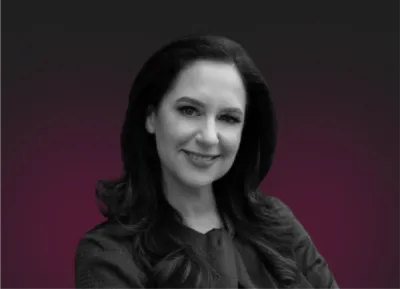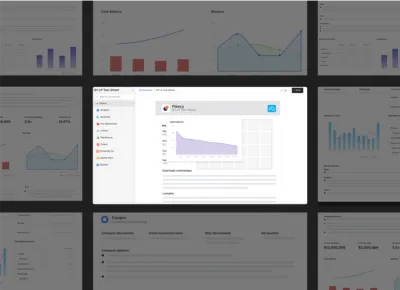Blog
Visible Blog
Resources to support ambitious founders and the investors who back them.
All
Fundraising Metrics and data Product Updates Operations Hiring & Talent Reporting Customer Stories

founders
Fundraising
Determining if an Accelerator is Right For You with Lisa Besserman of Expa
On episode 9 of the Founders Forward Podcast, we welcome Lisa Besserman. Lisa Besserman is the Managing Director at Expa — an accelerator based in Austin, TX dedicated to supporting pre-seed companies.
About Lisa
Lisa started her career as an economist but ultimately found her way to founding Startup Buenos Aires — an accelerator located in Buenos Aires to help support startups in Latin America. Since then, Lisa has made the move to Expa where is the managing director of their accelerator. Between her time at Startup Buenos Aires and Expa, Lisa has a wealth of knowledge related to all things company building, fundraising, and leading — especially at the early stages.
Our CEO, Mike Preuss, had the opportunity to sit down and chat with Lisa. You can give the full episode a listen below (Or listen on Spotify, Apple Podcasts, or any standard podcast player):
What You Can Expect to Learn from Lisa
How founders can best connect with investors
How to determine if an accelerator is right for your business
What kind of companies Expa is interested in funding
Why founders should try their best for a warm intro
What she likes to see in a cold email
How to determine how much to raise
What she thinks the future of VC looks like
Related Resources
Lisa’s Twitter
Lisa’s LinkedIn
Application to apply for Expa
Expa’s Visible Connect profile

founders
Fundraising
How to Raise Your Series A With Michael Rangel of Novo
Building a company is difficult. Being a founder can almost feel impossible. There are very few people that have been in the shoes of a founder. As a startup founder, there is no one better to learn from than the person that has been there before.
The team at Novo recently raised a $41M Series A. Novo’s CEO, Micheal Rangel, was generous enough to join us and talk about how they raised it. Micheal breaks down everything from his preparation to pitch to metrics and more.
A few topics we discuss:
Determining if you are ready for your Series A
How to prepare yourself for a raise
How to prepare your company for a raise
How to prepare your pitch and documents for a raise
How to craft your Series A pitch deck and narrative

founders
Fundraising
The Past, Present, and Future of VC Funding with Anne Dwane of Village Global
On episode 8 of the Founders Forward Podcast, we welcome Anne Dwane. Anne is the partner and co-founder at Village Global — an early-stage venture capital firm backed by successful entrepreneurs.
About Anne
Anne has a unique perspective on the VC space as she founded her first successful startup, Military.com, in the 1990s. After Military.com, Anne founded a startup later acquired by Chegg where she helped scale as they went public. Anne joins us to share what she has learned from time in the space. We discuss who founders should look to for advice, the thought process behind the roster of Village Global’s LPs, and how founders can build a fundraising process.
Our CEO, Mike Preuss, had the opportunity to sit down and chat with Anne. You can give the full episode a listen below:
What You Can Expect to Learn from Anne
What Anne learned from helping scale Chegg
How the startup world has transformed since her time founding Military.com in the 90s
Why founders should look for a “thought partner”
Why founders funding founders is a good thing
How to build a fundraising process
What she likes to see in a cold email from a founder
Related Resources
Anne’s Twitter
Anne’s LinkedIn
The Village Global application
Village Global’s Visible Connect Profile

founders
Fundraising
Product Updates
Introducing Decks — Manage Your Raise From Deck to Check
The pitch deck is the core marketing asset that jumpstarts any fundraising effort. It acts as the catalyst for connection, conversation, and relationship building.
How Pitch Deck Sharing Works
We talked to hundreds of founders, and three problems emerged around pitch deck sharing:
I’m not sure how prepared a potential investor is before heading into a meeting.
I’m under-networked. I share my deck to get meetings but want to understand who is engaged.
I iterate on my deck every hour. Sharing the latest version is a pain.
Introducing Visible Pitch Decks
Today, we are launching Decks. A dead-simple way to host and share a pitch deck on Visible. Decks are completely integrated with our fundraising crm and leading investor updates platform. You’ll be able to set customized sharing permissions, notifications when investors view your deck, upload new versions without clicking a button, and understand how potential investors have engaged with your content.
Just as a sales team has dedicated tools for their day-to-day, founders need dedicated tools for managing the most expensive asset they have, equity. Our community can now find investors, track a fundraise, and share a pitch deck directly from Visible and completely integrated.
Want to see a Deck hosted on Visible in action? Take a look here.
Whether we are building fundraising automation with our Zapier Connection or crafting integrations with companies like ProfitWell, we are driven by giving founders a better chance of success. It is going to be a very fun fall 😉
Up & to the right,
Mike & The Visible Team

investors
Reporting
4 Tear Sheet Examples to Give You Inspiration for Your Next LP Report
Tear Sheets (also known as one-pagers or fact sheets) are an effective way to communicate the performance of your portfolio on an individual company level. In Venture Capital, tear sheets are commonly shared with Limited Partners (LPs) on a monthly or quarterly basis to keep investors updated on company performance.
Common Tear Sheet Elements
Some common elements that should be included in tear sheets are:
Investment performance – Cost, value, board information
Financial metrics – Revenue, Cash Balance, Burn Rate, Runway
Company-specific KPIs – Keep this consistent for each reporting cycle.
Commentary – Add your own analysis on company metrics and performance.
Company context – Include details such as the company description, sector, HQ location for context.
Download Our Tear Sheet Examples
Download our packet of Tear Sheet Examples built with Visible.vc’s software for investors for inspiration before your next reporting cycle:
With Visible.vc you can create professionally formatted Tear Sheets for your entire portfolio within minutes. To learn more, schedule a demo with our team.

founders
Fundraising
Operations
Customer Stories
How Design Can be a Competitive Advantage with Kristian Andersen of High Alpha
On episode 7 of the Founders Forward Podcast, we welcome Kristian Andersen. Kristian is a founder and partner at High Alpha, a venture studio located in Indianapolis.
About Kristian
Before launching High Alpha, Kristian founded the prolific design agency, Studio Science. During his time at Studio Science, Kristian primarily served software companies which ultimately led to him being a founding partner at High Alpha. Between Kristian’s experience at Studio Science and his time at High Alpha helping launch 30+ companies, it is safe to say he knows a thing or 2 about design and storytelling. Kristian joins us to break down how design can be a competitive advantage, the importance of storytelling in business, the High Alpha Studio model, and much more.
Our CEO, Mike Preuss, had the opportunity to sit down and chat with Kristian. You can give the full episode a listen below:
What You Can Expect to Learn from Kristian:
How the High Alpha Studio models work
What kind of co-founders they look for at High Alpha
How design can be a competitive advantage
Why storytelling is important in business and fundraising
Why Coco Chanel, Teddy Roosevelt, and Ralph Lauren are great storytellers
What he likes to see in a cold email from a founder
Related Resources:
Kristian’s Twitter
Kristian’s website
Apply to become a High Alpha Co-founder
High Alpha’s Visible Connect Profile

founders
Fundraising
Reporting
10 Fundraising Takeaways from Season 2 of the Founders Forward
We are just over halfway through season 2 of the Founders Forward. We’ve talked to 6 awesome investors and have dug into everything from pitch decks to mental health.
To recap the first half of the season, we’ve shared our favorite quotes and thoughts from the season so far below. If you’d rather skip to a specific episode, you can do so below:
The Supply & Demand of Venture with Kenn Shasta
One of the questions we have asked all guests this year is, “What is one tip to help founders create momentum in their fundraise?” We’ve heard a flurry of great answers but really love the advice from Kenn So of Shasta Ventures.
Kenn recommends founders start to include target investors on their monthly/quarterly Updates. This way investors already know what’s going on and have already build a trend line when it comes to your company. Give the full episode a listen below:
Creating Momentum in Your Fundraise with Brett Brohl
One of the most common mistakes we see founders make is underestimating the amount of time it takes to complete a fundraise. From finding and researching investors to signing a term sheet can take 5+ months. We love how Brett Brohl of Bread & Butter Ventures broke down a fundraise into 5 months, or 1-3-1:
1 month — Researching and finding the right investors
3 months — Actively pitching investors
1 month — Time to close after it is fully committed
To learn more fundraising tips and advice for seed-stage founders, give the full episode with Brett a listen below:
How to Create FOMO During a Fundraise with Elizabeth Yin
When going out to raise a round of capital, most founders assume that you should try to find a few large investors that can fill the round so you can be done. However, Elizabeth Yin of Hustle Fund argues that small checks can be a really powerful tool.
While there are certainly some downsides, smaller checks allow you to create momentum and build your network. Elizabeth shared an example of a portfolio company that landed one small investor who ended up introducing them to the majority of their investors. Give the full episode with Elizabeth a listen below:
Building a Calm Company with Tyler Tringas
One of the questions we have asked all guests is, “What catches your eye in a cold email from a founder?” Tyler Tringas of Calm Company Fund had a great and unique take. Tyler likes to see a quick video of the product actually working. This can help create excitement and give him an idea of the state of the product.
Give our episode with Tyler a full listen below:
How Founders Can Address Their Mental Health with Ezra Galston
Before sitting a meeting with an investor there is an expectation that you will send over some kind of pitch deck or data or synopsis. Some investors will tell you full deck. Others might suggest a mini-deck. Regardless of the medium, Ezra Galston of Starting Line just wants enough context to have a good conversation.
Sending over enough context beforehand enables Ezra to understand some basics and have enough information to dig into questions and have a strong conversation. Give our interview with Ezra a full listen below:
All Things Community-Led Growth with Corinne Riley
A seed-stage and Series A fundraise can feel quite different for a founder. At the seed stage you likely have little to no revenue, few metrics, and a simple product. By the time you get to your Series A, you likely have product-market fit and have a solid revenue base. While the business might look different, some parts of your pitch stay the same.
We love how Corinne Riley of Greylock breaks down constant things she looks for in a pitch, regardless of stage. Give the full episode with Corinne a listen below:
How Design Can be a Competitive Advantage with Kristian Andersen
A successful pitch and story can make or break a fundraise. As the co-founder of the venture studio, High Alpha, Kristian has helped countless early-stage companies craft their narratives and build their pitch deck.
In our interview with Kristian, he points out the importance of starting with your story when crafting your pitch deck.
The Past, Present, and Future of VC Funding with Anne Dwane
As a first-time founder, finding someone you can lean on for advice and experience can be crucial. Anne Dwane of Village Global recommends that founders can find a “thought partner.” This might be a peer that is someone who is at a similar stage or only a step or 2 ahead.
Determining if an Accelerator is Right For You with Lisa Besserman
The importance of being able to send a strong cold email was a consistent topic with all of our guests this season. More than anything else, Lisa Besserman of Expa likes to see a deck from a founder. In our interview with Lisa, she breaks down what specifically she likes to see in a deck as well.
How to Build an Investor List with Gale Wilkinson
Fundraising generally mirrors a traditional B2B sales funnel. Just like a sales funnel, you need leads and a strong customer profile at the top to fuel your process. Gale Wilkinson of Vitalize suggests that founders have a running list of investors that are a fit for your business.

investors
Operations
5 Actionable Steps to Improve Diversity at Your VC Fund
If you’re working in Venture Capital or are fundraising from VC’s, the odds that you’ve experienced a lack of diversity in race, gender, and as a result ideas, is very high.
According to a survey by Richard Kerby at Equal Ventures, the VC industry is comprised of 58% white men, followed by 20% Asian men, 11% white women, 6% Asian women, 2% Black men, and 1% Black women, 1% Latinx men, and nearly 0% are Latinx women.
And when you consider “who controls venture capital dollars”, in other words, “who gets the bulk of the carried interest, salary… and ultimate control over which startups get funded”, it’s 93% white males. (Source)
Source: James L. Knight Foundation; data extrapolated from Figure 41 based on Preqin’s data set, which defines venture capital as a subset of private equityH VENTURE PARTNERS
Meanwhile, a report by McKinsey and Company shows that diverse working environments financially outperform homogenous workforces by as much as 35 percent.
The Venture Capital industry is missing out on diversity of people, ideas, ventures, and ultimately higher returns.
If you’re interested in helping improve diversity at your VC fund, check out these resources to start taking actionable steps forward.
1) Increase Your Individual Knowledge about Diversity and Inclusion
It’s important to remember to take ownership of your diversity and inclusion education process rather than burdening minority groups with the responsibility of teaching you or correcting you.
You can start by checking out this curated list of relevant articles on diversity and inclusion for both founders and funders. The list also includes a list of organizations you can work with to help improve diversity and inclusion including Parity.org, NVCA VentureForward, and Project Include.
These resources are curated by Founders for Change, a group of inspiring founders who are dedicated to diversity and inclusion within their companies, and desire greater diversity at the highest levels of VC firms. Learn more about Founders for Change here.
2) Encourage Your Fund to Take Part in the Diversity VC Standard Program & Certification
The Diversity VC Standard program is a great way to strategically set diversity goals for your fund while also increasing the knowledge of D&I practices for your whole team. It was started in 2020 and pioneered by 15 leading funds across Europe and Canada. The certification sends signals to the rest of the ecosystem that your fund follows the best D&I practices.
The program walks VC’s through three stages:
Assessment – A guided run through of your fund’s current policies and practices
Consultation – Curated advice and recommendations on next steps according to fund targets
Certification – To Level 1 (setting a benchmark above industry average) or Level 2 (leading the way on changes to D&I policy)
For more information about Diversity VC follow this link.
3) Broaden Sources of Dealflow Beyond Traditional Channels
While cold outreach does sometimes work, most deals are funded through a warm introduction from someone in your network. For this reason, it’s a good idea to reflect on who comprises your network and decide if you need to branch out.
Some advice from Sarah Millar, Principal at City Light VC and head of Diversity VC’s US Chapter —
Be intentional about building relationships with funds that focus on diverse founders and leverage those to grow your own networks. Setting up regular catch-ups, co-investing in their deals, and sharing deals is always what works in VC – so being intentional about who you do it with and what their focus areas are is going to pay dividends.
Harlem Capital has put together a thorough database of diverse investors that is a great starting point.
You can also broaden your dealflow sources by checking out these resources: Crunchbase’s Diversity Spotlight, the Black Founder List, Latinx Founders Collective, Female Founded Club.
4) Guide Portfolio Companies on How to Build an Inclusive Culture
As a VC, you’re oftentimes in a position to influence your portfolio companies as they grow. Get informed about what makes a diverse and inclusive culture so you can guide your portfolio companies as they build their teams.
A great place to learn about inclusive cultures is by checking out the resources put together by Project Include. The non-profits mission is to give everyone a fair chance to succeed in tech by using data and advocacy to accelerate diversity and inclusion solutions.
Project Include has even curated recommendations on each step in the process of building an inclusive culture, including how to lead as a VC.
Leading the change to improve diversity at your VC fund may not be easy but we hope these resources serve as a source of motivation and encouragement.
5) Explore Diverse Networks when Making your next Fund Hire
When looking to add talent to your VC firm, start by exploring organizations on a mission to increase diversity in Venture Capital.
Vencapital is empowering the next generation of investors by providing training programs catered specifically towards women and minorities looking for entry-level roles in VC.
Chicago:Blend is on a mission to advance diversity, equity and inclusion in Chicago’s venture capital and startup community. They publish annual diversity data, help underrepresented and overlooked professionals break into VC, and deploy necessary DEI resources to the community.
You may also like How to Hire for your First VC Platform Role.
Do you have suggestions for other steps or resources you think we should include? Let us know!

founders
Fundraising
How to Model Your Seed Round With Yin Wu of Pulley
Raising capital in the early days of your business can have major implications later in your company lifecycle. Yin Wu, CEO of Pulley, joined us to walk through what to consider when determining how much to raise, setting valuations, and more.
Yin joins us to talk about all things fundraising, cap tables, valuations, and dilution. You can expect to dig into some of the following topics
Who should raise venture capital
What is impacting recent valuations
Raising using SAFEs
Determining how much to raise
Setting your company valuation
How much dilution a seed company should expect to see

founders
Fundraising
Operations
Metrics and data
All Things Community-Led Growth with Corinne Riley of Greylock
On episode 6, season 2 of the Founders Forward Podcast, we welcome Corinne Riley. Corinne is an investor at the prolific venture capital firm, Greylock, where she primarily invests in B2B companies.
About Corinne
Over the course of her career, Corinne has built a knack for helping companies build and develop a go-to-market motion. Corinne has extensive knowledge of community-led growth and helping companies grow at the earliest stages of their business. Corinne joins the show to break down community-led companies and the thought process behind her investment decision-making.
Our CEO, Mike Preuss, had the opportunity to sit down and chat with Corinne. You can give the full episode a listen below:
What You Can Expect to Learn from Corinne
What a community-led company is
How community-led growth can be a moat
What the community commitment curve is
What changes between a seed and series A pitch
What data she would expect to see in a Series A company
What she likes to see in a cold email from a founder
Related Resources
Corinne’s Twitter
Common Room & Uncommon
Corinne’s post on Community-Led Growth
The Business of Belonging
Greylocks’s Visible Connect Profile

founders
Fundraising
Mike’s Note — Progressive Disclosure
Progressive disclosure is an interaction design principle that sequences screens, so users do not feel overwhelmed and inevitably bounce.
Progressive Disclosure & Fundraising
Founders should take note of this principle when reaching out to potential employees and investors. Your goal is always to get to the next step, not get hitched after 2,000 words. If you are connecting with someone for the first time, your goal should be to receive a response. Keep things between 50 to 250 words (just like this note).
As Kunu says, do less.
Use Visible for Your Next Fundraise
No matter the series, size, or timing of your round, Visible is here to help. With Visible, you can manage every stage of your fundraising pipeline:
Find investors at the top of your funnel with our free investor database, Visible Connect
Track your conversations and move them through your funnel with our Fundraising CRM
Share your pitch deck and monthly updates with potential investors
Organize and share your most vital fundraising documents with data rooms
Manage your fundraise from start to finish with Visible. Give it a free try for 14 days here.

investors
Hiring & Talent
How to Hire for Your First VC Platform Role
What is a VC Platform?
First off, if you’re reading this article because you haven’t fully wrapped your head around what a VC Platform is, that’s ok. The term Platform is still relatively new in the VC world with the first VC Platform roles being formalized around 2013.
The term VC Platform can be defined as formalized post-investment support and services that VCs provide to their portfolio companies to help increase their chances of success and differentiate the VC firm.
Stephanie Manning from Lerer Hippeau decoded the VC Platform role and explains that a Platform role (or roles) vary by title but responsibilities typically fall into these six buckets:
Talent
Business Development
Content, Marketing & Communications
Community & Network
Operations
Events
In sum, Platform roles help formalize the post-investment support processes and make them repeatable and reliable.
This image is from the Lerer Hipeau Blog Post Paths into Venture Capital: Decoding the VC Platform role.
Related resource: How to Get Into Venture Capital: A Beginner’s Guide
Why VC Platforms Roles Exist
VC Platform roles exist for two main reasons —
To scale support — Investors get spread thin as their portfolios grow and they need a way to scale their support.
To differentiate one firm from another — At the end of the day, VC’s are all selling the same product, capital, and need a way to differentiate themselves to attract deal flow.
Different VC Platform Approaches
Although the objectives of all VC Platform roles are the same (see above), VCs take different approaches to Platform based on the needs of their portfolio, available resources, and differentiation strategy.
If you’re hiring for your first Platform role, it’s likely you don’t have a Platform strategy defined yet. This is completely ok to start, but would heed the advice from Jay Acunzo from NextView Ventures and note that “platform only works when you’re known for something”.
Acunzo goes on to suggest the following:
Firms with broader investment strategies should pick another focus area to ensure platform success, whether by owning a tactic (e.g. workshops, video, etc.), a business function (e.g. recruiting, design) or a sector (B2B SaaS). Even if a firm invests outside that industry, it’s still a better approach to be truly meaningful to one audience than mostly forgettable to many.
With this in mind, right before or right after your first hire, you should be thinking about where portfolio needs, available resources, and your VC brand align.
Check out our post on Defining your VC Platform Approach which includes a VC Platform Positioning Exercise template to kick off your brainstorming.
What to look for in your first VC Platform Role
Although you’ll eventually want your Platform to specialize and “be known for something” if you don’t know what that “something” is yet, we suggest looking for someone with marketing, events, or recruiting experience as a first hire. Previous experience with startups or working in Venture Capital is a major bonus but making it a requirement may narrow your search significantly.
Jack-(or Jill)-of-all-trades type often do well in platform roles because they’re going to be wearing several hats at once. When interviewing candidates look for someone with a proven record of creating things from scratch (from idea to implementation) because you’ll want to find someone who has the ability to try out a few different approaches to post-investment support and be ok when some flat-out don’t work.
They’ll also need to be a persuasive communicator because they will need to convince both your investment team and your companies to try new ideas.
And finally, as you think long-term about how your portfolio and Platform will grow, you may envision this person managing a Platform team. Therefore, it’s a good idea to hire someone who has the organization and leadership skills required to lead a team.
A summary of traits to look for:
Building relationships is second nature
Enjoys organizing events and bringing people together
Takes a creative approach to problem-solving
An idea generator AND executor
Ability to wear multiple hats and remain organized
Previous experience working with startups or at a startup
Can deliver on projects with little guidance from others
Demonstrated ability to communicate effectively and persuasively
Aptitude for managing a team
Writing the VC Platform Role Job Description
To get started with writing the job description for your first VC Platform role, it’s a good idea to check out real examples from other firms.
Here you can find a public-facing VC Platform Job Board which includes job descriptions for various types of Platform roles.
You could also utilize LinkedIn and search for VC Platform Manager or Director of Platform to view open roles from other funds.
How to set your VC Platform Manager up for Success
You may find managing someone in a Platform role to be challenging from the perspective that their work may seem unrelated to the focus areas of other fund staff. And that’s because it is.
Ask any first Platform hire and they will undoubtedly tell you they felt isolated and even lonely in their role. This is why it’s critical to encourage the new hire to create their own peer network of people in platform roles outside of the fund. This network can also help them upskill more quickly and have people who understand their work to bounce ideas off.
Thankfully, a welcoming community of people like this already exists. The VC Global Platform Community is a network of people in platform roles around the world who connect virtually (via a forum, video calls, and events) to discuss best practices, exchange ideas, and foster relationships.
You can additionally support the new Platform hire by backing them up when they want to implement new ideas and need buy-in, and ensuring there are opportunities for them to be heard. A Platform person’s nightmare is being excited about rolling out a new idea but not being able to get the ‘air-time’ with relevant team members to push it forward. As a manager, you can keep this communication channel open by setting up a regular (try quarterly) meeting between the Platform hire and the investment team to discuss post-investment support initiatives and decide on next steps.
Consider using Visible.vc’s portfolio reporting tools to increase transparency between your Platform team and Investment team.
And finally, your new Platform hire will want to know their work is making a difference. It’s a good idea to challenge them to come up with their own method for defining and measuring success for improving and formalizing your fund’s post-investment support. Check in with them about these goals on an agreed upon cadence.
Hiring your first VC Platform role is a great way to scale the post-investment support you offer your portfolio companies and to differentiate your fund from the sea of other capital providers.
However, it’s not always easy given this hire will be working on initiatives that other staff members haven’t previously dedicated much time or resources to. But with the right person, and by being intentional about setting them up for success, this new hire can add immense impact to your fund’s performance.
Visible for Investors is a founder-friendly portfolio monitoring and reporting platform.

investors
Operations
Defining Your VC Platform Approach Using the TOPSCAN Method
You may be interested in better defining your VC Platform approach because you’re thinking about hiring for your first Platform role or you want to strategically determine where to allocate more resources to improve your post-investment support. Whatever the reason, it’s a worthy investment of your time because your VC Platform can help set you apart from other investors in a competitive deal flow environment.
Despite the importance of the topic, not very many frameworks exist to help investment teams and Platform teams figure out how to improve the support they’re providing startups. This article highlights the TOPSCAN method and serves as a useful tool to take a wide lens view at the needs and resources that already exist within your portfolio today.
What is the TOPSCAN Method for Startup Support?
The TOPSCAN method for supporting startups is a hidden gem of a framework first outlined in 2013 in The Journal of Private Equity. It was designed to help investors improve their operational support of startups.
The framework includes seven key management techniques as outlined below:
Using this framework, and the exercise outlined below, you can strategically determine the areas of support that will deliver the most value to your companies and reap the most return for the investment of your VC Platform’s time and non-capital resources.
Using TOPSCAN to Identify your VC Platform Positioning
The objectives of VC Platforms are all about formalizing the post-investment support processes and making them repeatable and reliable. Therefore, you want to make sure you’re scaling your most impactful areas of support.
To discover which areas of support are going to be the most valuable to scale from both your portfolio’s and your fund’s perspective, you should be thinking about where portfolio needs, available resources, and VC brand strategy align.
To do this, consider using this VC Platform Positioning Exercise template as a guide.
VC Platform Positioning Exercise
Portfolio Needs
To get started, navigate to the Portfolio Needs column on the VC Platform Positioning Exercise. Here you’ll begin to answer the question What is the most impactful support you could be providing your companies?
The exercise starts with this column because it is absolutely critical to have a finger on the pulse of what is top of mind for your portfolio companies.
Just as you would never advise one of your portfolio companies to build a product without first understanding their customer, you need to understand your portfolio companies (read: customers) before you start building out your VC Platform approach.
To do this, you could consider:
Sending out a survey;
Using Visible.vc’s Request feature to streamline the collection of qualitative responses; Or
Scheduling a check in call with your founders during which you ask ‘what is the most impactful way we can support you’*
*If you don’t have strong relationships with companies already in place, start by setting up informal check in calls to build rapport instead of a survey.
Document the trends you see emerging across the portfolio using the TOPSCAN categories of support which are included in the VC Platform Positioning Exercise. You’ll also want to assign a weight to each category according to the level of demand or need. Portfolio Needs Example:
Available Resources
Next, review and consider which resources for company support already exist at your firm. Your goal should be to answer the question What resources do we have internally and/or how could we source these externally?
Start mapping out these resources by the TOPSCAN category they’re related to. Take into account which resources your VC Fund has internally versus where it could make sense to partner with a service provider. Assign a weight related to how available the resources already are within your firm.
For example, your portfolio may need help with recruiting but you don’t have resources on staff to support this. In this case, you may consider whether there is a budget to adopt a software or form a partnership to provide this type of support to your companies. Available Resources Example:
Brand Strategy
And finally, it’s important to keep in mind your fund’s brand positioning to make sure the resources you’re allocating align with your brand. In this section you’re answering What do we want to be known for?
As Jay Acunzo from NextView Ventures notes “platform only works when you’re known for something.”
Brainstorm within your team until you’ve clarified what it is you want to be known for. Do you want to be known for data-driven decision making? Or maybe you want to be known for identifying and investing in diverse teams. Denote this in the ‘Brand Strategy’ section of the exercise and again assign a weight to each category as you fill them out. Brand Strategy Example:
Once you’ve completed the VC Platform Positioning Exercise, begin looking for overlaps in portfolio needs, available resources, and brand strategy. The areas in which you identify the most alignment should form the basis of your VC Platform approach.
And as Peter Drucker once said, “You cannot manage what you don’t measure”. Be sure to set up KPI’s for your newly defined VC Platform approach so you can measure, analyze, and iterate as needed to refine your approach overtime.
And with building anything new, keep in close communication with your ‘customers’ so you’re confident you’re building something of value.
Other VC Platform articles we love:
Paths into Venture Capital – Decoding the Platform Role
Director of Platform, what does that mean?
Why VCs are investing in Platforms to Compete
Are Newly Formed Roles In VC Firms Differentiators, Table Stakes Or Total BS?

founders
Fundraising
Operations
How Starting Line Helps Founders Address Their Mental Health with Ezra Galston
On episode 5, season 2 of the Founders Forward Podcast, we welcome Ezra Galston. Ezra is the founder and partner at Starting Line, a consumer-focused VC fund located in Chicago.
About Ezra
As someone who has faced the ups and downs of being a founder (plus the stresses of fundraising), Ezra and the team at Starting Line has made mental health a focus. Every founder in the Starting Line portfolio receives a subsidy for “their first three sessions of therapy, executive coaching, or co-founder counseling (up to $200 each).” Ezra joins the Founders Forward to break down fundraising, founder health, and the consumer market/what excites the team at Starting Line.
Our CEO, Mike Preuss, had the opportunity to sit down and chat with Ezra. You can give the full episode a listen below:
What You Can Expect to Learn from Ezra
How a founder and board’s focus changes from early stages to later stage
How venture fundraising differs for the “haves” and “have nots”
How Ezra’s experiencing raising capital has impacted how he views fundraising
Why Starting Line has a focus on their portfolio founder’s mental health
How Starting Line subsidizes mental health sessions
Why fundraising is a relationship-based activity
Why he likes plenty of context before a meeting with a founder
Related Resources
Ezra’s Twitter
The Starting Line Operating Manual
Starting Line’s Visible Connect Profile

founders
Operations
Reporting
How To Build a Board of Directors That Actually Helps
What a Board of Directors Does
Even with great executives, a great product, and a great team, the success of a new startup can be determined by its Board of Directors. Choosing a Board of Directors is a critical process. The Board of Directors for your venture are the strategic advisors or final votes in major decisions and changes. With the right Board in place, a company can accelerate and take the right strategic steps to a favorable exit or IPO.
Building a Board of Directors is a crucial process and one that should be done deliberately and strategically. Decisions about the type of board your company needs, the types of board members and how they will strategically work together, and planning ahead for potential board obstacles and stumbling points are all aspects to consider when building a Board of Directors that will actually help your company grow.
What a Board of Directors Does
At the highest level, a Board of Directors provides some type of strategic advisory and decision making for a company. In some cases, and for some types of boards, this decision-making could be fiscal and provide the board members the electoral power to make changes above the company’s executives. In other cases, it can be purely strategic, with no formal and final power but rather to serve as a collective of experience and guidance as the company grows and evolves over time. In general, a Board of Directors serves as a voting or advisory body of appointed or elected leaders that help make decisions for a company. There are nuances and three primary types of Boards of Directors.
The Different Types of Boards
Board of Directors
A Board of Directors is made up of appointed members typically representing from inside the company and outside the company. Board of Director members are experts in their field, fields relating to company leadership or aligned strategically with what a company does or what industry they serve. A Board of Directors may serve in an advisory role or a fiduciary role or both. These two types of boards are most common. Inside company representation may include leaders of the executive board and even the CEO of the company. Outside appointees vary depending on the type of Board of Directors. The type of board of directors can also influence how a specific board meeting is run. Check out our guide on How to Run a Board Meeting to learn more about the various meeting flows.
Advisory Board
The main differentiator of an advisory board is that its decisions are non-binding and more informal in nature. Just as the name suggests, Advisory Boards are composed of appointed experts that provide advice and help a company with forward-thinking decisions such as custom acquisition, go-to-market strategy, category tactics, pricing, or even acquisition decisions. Advisory Board cannot force a CEO or executive team to take any action. They are also not appointed to represent any specific interests, rather composed of folks that are experts in their field or have strong track records of scaling great businesses. Sometimes, in exchange for an Advisory Board seat and contributing their time and help to a company, the stock is given as part of the “payment” for serving in an Advisory Board role. This also ties the advisory board member to the company’s long-term success. In general, Advisory Boards do not assume any liability or responsibility legally from company decisions and outcomes.
Fiduciary Board
First and foremost, Fiduciary Boards are made up of an equal representation of all the shareholders, not just majority owners. Public companies are required to have Fiduciary Boards but Private companies are not. Fiduciary Boards are tasked with ensuring that the company is making decisions that are fiscally beneficial to its shareholders. Because of this heavy responsibility and oversight, Fiduciary Boards are given the voting rights to overrule the CEO’s decisions. Members of a Fiduciary Board are appointed by each party they represent. Often, when a big funding round takes place, the leading investor of that round will appoint a partner to sit on the Board of Directors at the company – earning a board seat as part of their investment to represent their fiduciary interests. Inside the company members are present as well including the CEO and possibly another C-level executive.
The Different Types of Board Members
Not only are there different kinds of Boards of Directors, there are also a variety of different types of board members that make up said boards.
Management Board Members
Internal representatives on a Board of Directors from the company are referred to as management board members. Management board members are direct representatives from the day-to-day of the company, often the CEO, COO or another executive leader. They provide the frontline perspective into the discussions and decision-making for the board and are often responsible for running the agenda and managing the flow of information out to the rest of the board members.
Investor Board Members
Often, when a VC firm or PE firm makes an investment into a company’s funding round, they are granted representation with a board seat. Investors that join your board at different stages of a company’s growth may have different perspectives or rationale around upholding specific decisions or fiduciary responsibility. It’s critical that you spend the time onboarding not only the board seat holder, but your broader team of new investors after every round.
Independent Directors
Knowing that management members and investor members both have direct ties to the success of the company and are personally tied financially to the outcomes decided on by a board, independent directors provide an air of checks and balances to the table. Independent directors are qualified individuals that have no affiliation or tie to the company. They may be business leaders or industry experts and are there as a 3rd party, non-bias advisors to the business.
How To Build a Strong Board of Directors
Now knowing that there are various types of a Board of Directors and various members that make up those ranks, the decision-making process begins to form the perfect board for your company’s needs and future.
Choosing a Board Type
First and foremost, if your company is public, a fiduciary board is required. However, if your company is private, you have the option to build a board with just advisory duties or to grant them fiduciary power as well. It’s important to consider why each function exists. Choosing an advisory board is smart for any founder to make sure their company building does not exist in an echo chamber, and insight and advice is considered early and often as the company scales. The more external funding you take and the more shareholders are present, fiduciary responsibility may make the most sense to protect the overall interests of the company and spread out the risk and legal responsibility amongst shareholders, not just on the executive leadership at the company.
Deciding on a Board Size
There is no mandatory set number of Board Members, and most range from 3 to 31 employees. Typically a board is always composed of an odd number to prevent tied votes. Analysts suggest that the ideal Board of Directors size is 7 members. Deciding on your Board size is up to you as a founder. Perhaps a smaller board is good to start with expansions being made as more investors come to the table, earning more seats, or as new problems or growth opportunities arise at the company that requires new expertise to be brought in.
Establishing a Board Structure
In addition to Board of Directors Size and Type, the structure of the board is critical to the success of the board. Having a clear, and defined structure that is agreed upon by members as they join ensures that board meetings are run smoothly and the purpose and goals of the board are clearly achieved. Structural elements of a board to consider include setting clear bylaws that outline member responsibilities and expectations, defined roles, and duties such as who will take minutes, who will report out, and who will run the meeting flow at each board meeting. Term limits are also something to consider, especially for a fiduciary board, to keep decision-making ethical and tied to the best interests of the shareholders. Additionally, check if your specific industry or board type has any industry or corporate governance rules that are needed to be abided by.
Fill Knowledge and Skills Gaps
When appointing new board members, or even just as you appoint the first few board members, consider what skills they bring to the table and how they can best aid your company’s success. If there are gaps that the current management team or founders of the company have, a board of directors can help fill knowledge and skills gaps. For example, if the founders of a company are technical, they may want to build an advisory board of directors with go-to-market experts, revenue leaders, and financial advisors to ensure that the business decisions are made in conjunction with the great product evolution or development taking place. On the flip side, if a company is expanding into a new industry or adding a product line, an expert in that product field or industry may be a crucial knowledge gap to fill with a board seat.
Prioritize Diverse Perspectives
The best way to make sure your business actually grows from implementing a board and making forward-thinking decisions as a board is to avoid an echo chamber. An echo chamber refers to the same ideas or thoughts being “Echoed” back many times over. Often, it’s easy to be drawn to like-minded leaders or partners you’ve worked within the past when selecting board members. However, think more about the qualities and traits and perspectives the management members or already selected members bring to the table. Then try and find a completely opposite perspective or experience (that still helps your business). Avoiding an echo chamber will ensure all perspectives and sides of an idea are considered when making a decision and avoid obvious mistakes that might be made if everyone can only see one direction clearly.
Onboard Your Directors
Plain and simple, onboard your Board of Directors. Just as you would likely build out a comprehensive onboarding plan for your new employees so they have everything they need to do their job, the Board of Directors are no different. Provide a detailed, comprehensive, and repeatable path for onboarding for your Directors. This will ensure everyone is on the same page and has a clear understanding of the “why” that brings them to the table for your company each and every day.
Regularly Evaluate Your Board
If the board type and structure is set, all your Directors are onboarded, and you have your Board up and running, don’t stop thinking about what your Board’s ideal state looks like. Make quarterly and annual evaluations a habit with your Board to ensure that all members are continuously able (and willing) to serve in their Board role at full capacity. This ensures that your Board remains a valuable part of your business’s strategy and success.
Potential Obstacles to Your Board’s Success (and Solutions)
Despite taking all the steps to build a strong Board of Directors, be aware of potential obstacles to your board’s success.
Too many like-Minded Members
When building your board, especially early on, the board may be small. Between management members and investor or industry expert appointees, you always run the risk of having too many like minded members on the board, preventing any real change or growth to be done. The best solution to avoiding this potential obstacles is to be really intentional when building your board to diversity the perspectives represented and to set clear term limits for your board. That way, even if after working to select members with diverse perspectives, there is a second safety net in place to ensure that after a set number of time, board members will be interchanged to bring in even more perspectives and prevent a like-minded board from forming.
Conflicts of Interest
Another common obstacle many Boards of Directors face is a conflict of interest among board members. This could be due to too much management representation on the board or possibly too many friends and family represented on the board as shareholders. A solution on the management side is to ensure there is a cap on how many management members are represented at any one time on the board. This limit will prevent the management perspective from taking over. Similarly, term limits, or voting rules around stakeholder involvement can help ensure that decisions are made fairly and not just in the interest of the individual board member.
Let Visible Help
A Board of Directors can be game-changing for your business and completely shape the strategic direction to take a company public or through other favorable business outcomes. Once your Board is up and running, it’s important to ensure communications to the Board are seamless and clear. Learn more about keeping your investors updated with Visible here.
Unlock Your Investor Relationships. Try Visible for Free for 14 Days.
Start Your Free Trial